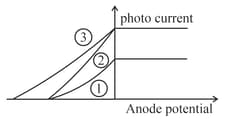EASY
Earn 100
Photoelectric emission from a metal begins at a frequency of . The emitted electrons are fully stopped by a retarding potential of . What will be the wavelength of the incident radiation?
Important Questions on Dual Nature of Radiation and Matter
MEDIUM
EASY
MEDIUM
EASY
EASY
The following graph represents the variation of photo current with anode potential for a metal surface. Here and represents intensities and represents frequency for curves and respectively, then

EASY
EASY
Guess the shape of curve which shows the variation of with v in case of photoelectric emission shown by the relation where symbols have their usual meaning.
EASY
EASY
The photoelectric threshold for a certain metal surface is . If the metal surface is irradiated by a wavelength of , the kinetic energy of the emitted photoelectrons is
EASY
EASY
EASY
MEDIUM
HARD
EASY
EASY
MEDIUM
EASY
EASY
HARD

